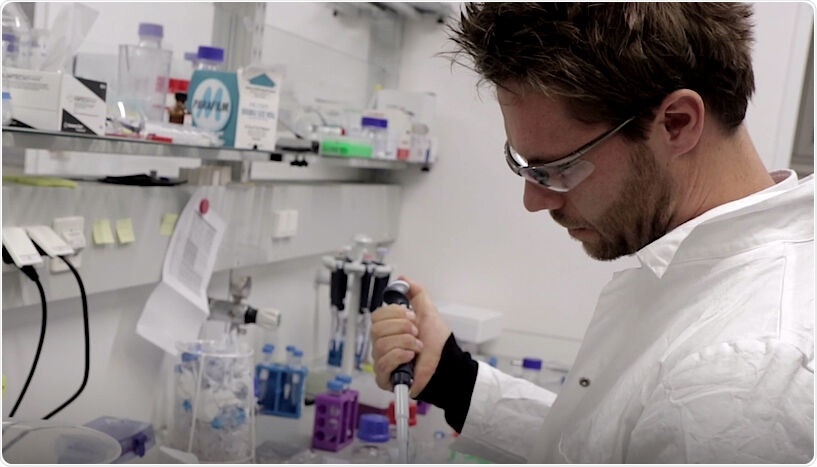Thanks to the interesting group of trefoil factor peptides, both industry and research could usher in better treatments for chronic disorders, like Crohn’s disease.

Studies demonstrated that trefoil factor peptides are locally produced to combat inflammation and injuries of the gastrointestinal tract by accelerating wound healing. Image Credit: © University of Vienna.
Researchers, headed by ERC awardee Markus Muttenthaler from the Faculty of Chemistry of the University of Vienna, have successfully produced and folded the TFF1 peptide, for the first time. TFF1 plays a crucial role in the repair and protection of mucosa.
Chemical synthesis of such gastrointestinal peptides is a major step to gain a deeper insight into their therapeutic potential and mode of action. The latest study was reported in the Chemical Communications journal.
TFF1, TFF2, and TFF3 are three familiar series of human trefoil factor peptides that are exclusively released by the gastrointestinal mucosa.
The molecules, which are dubbed after their trefoil-like folded structure, offer clinically fascinating properties. According to studies, peptides like these are locally released to fight injuries and inflammation of the gastrointestinal tract by speeding up the process of wound healing.
Hence, peptides have an excellent therapeutic potential for gastrointestinal disorders and other mucosal diseases, like asthma and the dry eye disease, as stated by the scientists in another review article published in ACS Pharmacology & Translational Science.
Local effects
To date, there are two oral peptide therapeutics against diseases such as irritable bowel syndrome on the market. Due to the relatively large size of the molecules, they are not being absorbed through the gastrointestinal wall into the bloodstream, and therefore can only act locally in the gastrointestinal tract without major side effects.”
Markus Muttenthaler, Medicinal Chemist, Faculty of Chemistry, University of Vienna
The group of trefoil factor peptides is “an essential starting point for new therapeutic strategies to treat chronic diseases that remain incurable,” explained Muttenthaler, who also heads research teams at the Department of Biological Chemistry at the University of Vienna and the University of Queensland based in Brisbane.
The studies are being performed in the framework of Muttenthaler’s ERC Starting Grant project, the aim of which is to reveal the wound healing mechanisms involved in the gastrointestinal tract.
Based on the chemical synthesis of the TFF peptides, we can now find answers to fundamental questions that we were not able to tackle before.”
Markus Muttenthaler, Medicinal Chemist, Faculty of Chemistry, University of Vienna
TFF1 acts as homodimer
The scientists have described how TFF1 and its homodimer are chemically synthesized, in their latest study. Homodimer is a type of molecule that contains a pair of TFF1 subunits. TFF1 can interact with mucins only when it exists in its homodimeric form. Mucins are key structural constituents of the gastrointestinal tract, which speeds up the closure of the mucosal barrier and also expedites its healing process.
The TFF1 peptide has a length of 60 amino acids, which means traditional techniques cannot be used to produce these molecules. To address this problem, the researchers devised a novel technique in which the peptide is produced in two fragments and subsequently assembled.
The second difficulty that needs to be overcome was to fold the TFF1 peptide correctly by choosing from a range of possibilities. Through structural analysis, proper folding was subsequently validated and the TFF1 homodimer was demonstrated to communicate with the gastric mucosa.
Along with his team, Muttenthaler is presently working on the chemical synthesis of the other two units of the trefoil factor group, TFF3, and the more complex TFF2, which is not only longer but also more complex with its 7 disulfide bonds and 106 amino acids.
New possibilities for molecular design
The chemical synthesis of the TFF1 peptide is regarded as a breakthrough in the field because it offers additional options to alter this class of peptide. So far, these molecules were produced only through the recombinant expression approach.
Therefore, their design was limited to the 20 natural amino acids. Chemical synthesis now enables us to design advanced TFF1 probes to study their mechanisms of action or to optimise TFF1 towards its therapeutic applications.”
Markus Muttenthaler, Medicinal Chemist, Faculty of Chemistry, University of Vienna
Molecular probes are crucial to gain an in-depth insight into the TFF1 peptide and also into its mode of action. Specific attachments, like fluorescent molecules, or other reporter tags can allow researchers to analyze TFF1 interactions with its target receptors or proteins.
For a more efficient therapeutic application, other alterations could be employed to further enhance the stability of the peptides as well as their drug-like characteristics.
Source:
Journal reference:
Emidio, N. B., et al. (2020) Structure, Function, and Therapeutic Potential of the Trefoil Factor Family in the Gastrointestinal Tract. ACS Pharmacology & Translational Science. doi.org/10.1021/acsptsci.0c00023.